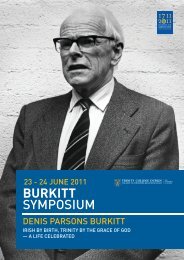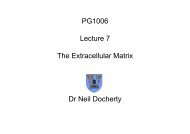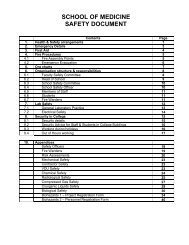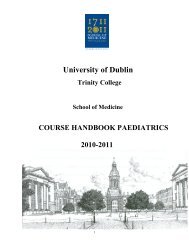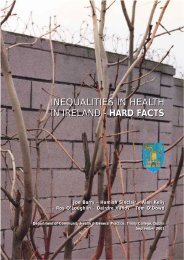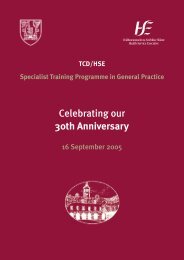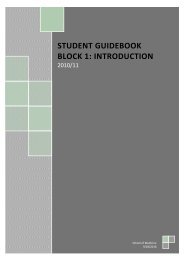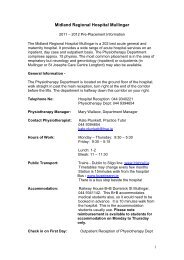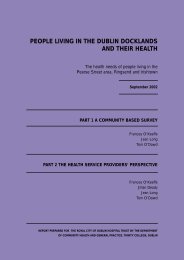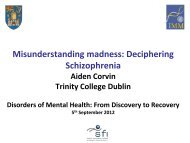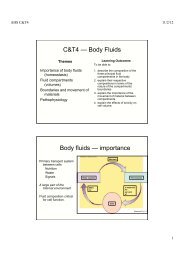Common-Clinical-Cond.. - School of Medicine
Common-Clinical-Cond.. - School of Medicine
Common-Clinical-Cond.. - School of Medicine
You also want an ePaper? Increase the reach of your titles
YUMPU automatically turns print PDFs into web optimized ePapers that Google loves.
<strong>Common</strong> <strong>Clinical</strong> <strong>Cond</strong>itionsin General Practice - IIDr. Brendan O’ SheaDepartment <strong>of</strong> Public Health and Primary Care<strong>Cond</strong>itions Covered• Session 1– Hypertension– Ischaemic heart disease / Angina / MI– Diabetes mellitus– URTI / LRTI• Session 2– Asthma– COPD– Low back pain– Arthritis / Joint pain– Thyroid DisordersAsthma• Case History– AM is an 8 y.o. boy who is brought in by his Mum.She says he has a terrible cough all the time, especiallyat night. He has a history <strong>of</strong> wheezing during viralinfections in the past.– What questions will you ask in the history?– What is your initial management plan?Asthma• Case History– He returns after a trial <strong>of</strong> salbutamol 2 puffs PRN for 6weeks.– Both he and his Mum feel he has been a lot better. Hisnight cough has settled. He uses his salbutamol mostdays, especially if it is cold outside. However, he had ahead cold 2 weeks previously and felt he was still quitewheezy during that week, despite the salbutamol.– What is your management plan?– What general advice will you give about preventingasthma flares?Asthma• Definition– Paroxysmal, reversible airways obstruction• Characterised by:– Airflow limitation, usually reversible spontaneously / with tx– Airway hyperresponsiveness to a wide range <strong>of</strong> stimuli– Inflammation <strong>of</strong> the bronchi• Prevalence– 5-8% <strong>of</strong> population (10-15% in 10-20 y.o. age group)– Occupational asthma accounts for 1-2% <strong>of</strong> adult cases– Assoc with FHx <strong>of</strong> atopy / asthma and PMHx atopy (e.g. hayfever / eczema); childhood bronchiolitis (40% develop asthma)Asthma• Diagnosis– Based on clinical picture – no diagnostic test– Symptoms and signs:• Wheeze• Paroxysmal SOB (esp at night / early morning, when peak flow dips)• Nocturnal cough (esp in children)• “Barrel chest” in chronic asthmatics– Consider:• Serial PEFR measurements – variability <strong>of</strong> airflow obstruction• Spirometry / PEFR: >15% ↑ FEV1 or PEFR post inhaled bronchodilator• Trial <strong>of</strong> corticosteroids: prednisolone 30mg OD x 2/52 - >15% ↑ FEV1 /PERF confirms reversibility and proves steroids will be beneficial in mgt• Bloods: FBC may show eosinophilia• CXR: usually normal; occasionally hyperinflation; excludes other causes1
Asthma• <strong>Common</strong> Precipitating / Exacerbating Factors– Exercise– Emotion– Weather – fog, cold air, thunderstorms– Air pollutants – smoke and dust– Household allergens – e.g. house dust mite, animal fur, feathers– Occupational exposure – animal products, wood dusts, graindusts, chemicals (e.g. isocyanates)– Smoking– Infection – e.g. viral URTI, chest infxns– Drugs – NSAIDs, β-blockers– GORDManagement <strong>of</strong> Asthma• Aims <strong>of</strong> Treatment– Abolish symptoms and minimise impact on lifestyle– Restore normal / best possible long-term airway function– Reduce risk <strong>of</strong> severe attacks– Enable normal growth in children• BTS / SIGN Guidelines on Mgt <strong>of</strong> Asthma (2004)– Primary Prevention – reduced incidence in breast-fed children– Non-Pharmacological Management• Allergen avoidance (esp smoking, house dust mite control)• Weight loss if obeseManagement <strong>of</strong> Asthma• BTS / SIGN Guidelines on Mgt <strong>of</strong> Asthma (2004)– Pharmacological Management• Treatment is based on stepwise approach– Start at step most appropriate to initial severity <strong>of</strong> symptoms– Aim to achieve early control, and then step down treatment– Ensure proper inhaler technique and trigger avoidance– A rescue course <strong>of</strong> steroids may be needed at any step, at any time• Selection <strong>of</strong> inhaler device– Use MDI if possible (dry powder inhalers are an alternative)– 75% <strong>of</strong> users have inadequate technique– Inhale slowly and hold breath for 10 seconds– Spacers / breath-activated devices are usefulManagement <strong>of</strong> Asthma• Drugs Used in the Treatment <strong>of</strong> Asthma– Short-acting β 2 -agonists – e.g. salbutamol (Ventolin), terbutaline(Bricanyl)– Anticholinergic bronchodilators – e.g ipratropium bromide(Atrovent) – preferred to salbutamol < 1y.o.– Long-acting β 2 -agonists – e.g. salmeterol (Serevent)– Inhaled corticosteroids – e.g. beclomethasone (Becotide),fluticasone (Flixotide), budesonide (Pulmicort)• Often available in combination with a long-acting β 2 -agonist – e.g.Seretide (salmeterol + fluticasone), Symbicort (formoterol + budesonide)– Leukotriene receptor antagonists – e.g. montelukast (Singulair)– Sodium cromoglycate and nedocromil sodium (Intal, Cromogen)Summary <strong>of</strong> Stepwise Management in Adults Summary <strong>of</strong> Stepwise Management in Children Aged 5-122
Summary <strong>of</strong> Stepwise Management in Children < 5 YearsCOPD• Case History– ET is a 68 year old lady who has recently transferred to yourpractice. She couldn’t manage the walk to her old GP anymore.She lives alone, and has a son living on the other side <strong>of</strong> the city– She gives hx <strong>of</strong> SOB when walking, especially if going uphill,or carrying anything. She maintains that she was fine up until 3months ago.– PMHx – known AAA, under surveillance.– What questions will you ask her in the history?– What signs will you look for on examination?– What investigations will you do?COPD• Case History– Her spirometry confirms the diagnosis <strong>of</strong> COPD (Stage 3).– What is your management plan?– She goes to see the vascular team. Her AAA is now 7cmdiameter. They recommend surgery as if it ruptures outside <strong>of</strong>hospital she will almost certainly die – but surgery has a 10%mortality also. At assessment she is found to be physically unfitfrom a respiratory point <strong>of</strong> view. She is told that they will haveto wait and see what happens – she is terrified.COPD• Case History– <strong>Clinical</strong> Course / Follow-Up:– She remains clinically stable on Seretide 250mg 1 puff BD andsalbutamol for a few months. She can’t give up the cigarettes.– She gets a chest infection and is admitted to hospital where sheis found to be in Type II respiratory failure with a PaO2 <strong>of</strong>7.8kPa on admission (retaining CO2 d/t hypoventilation). Sherequires BiPap for ventilation but pulls through. She istransferred to Peamount for 3 weeks rehabilitation and goes tolive with her son on home oxygen. Her life expectancy isprobably less than a year.COPD – GOLD Guidelines• Definition– Slowly progressive disorder characterised by airflow limitationthat is not fully reversible– Risk Factors:• Cigarette smoking (also pipes and cigars) – including passive• Occupational dusts and chemicals (intense / prolonged exposure)• Indoor air pollution (cooking fuels in poorly ventilated environment)• Outdoor air pollution (↑ burden <strong>of</strong> inhaled particles)• Resp infxn in early childhood• Genetic (bronchial hyperresponsiveness, α 1 -antitrypsin deficiency)• Diet (poor diet and low birthweight)• Race (Chinese and Afro-Caribbean have ↓ susceptibility)COPD• Prevalence– ≈16% in 40-68 y.o age group (M>F)– Causes 5% <strong>of</strong> deaths in Ireland (CSO 2005)• Presentation– Symptoms:• Cough- may precede development <strong>of</strong>• Sputum productionairflow limitation by years• Dyspnoea• Episodic exacerbations– Signs <strong>of</strong> severe disease:• Tachypnoea, prolonged expiration, use <strong>of</strong> acc ms <strong>of</strong> resp / intercostalindrawing on inspiration and pursing <strong>of</strong> lips on expiration, poor chestexpansion, hyperresonant chest, cyanosis3
COPD• Diagnosis– Suspect if• Chronic cough• Chronic sputum production• Repeated episodes <strong>of</strong> acute bronchitis• Dyspnoea that is progressive, persistent (every day), worseon exercise, and worse during resp infxns• Hx <strong>of</strong> exposure to risk factors• Investigations– Spirometry to confirm• ↓ FEV 1 and FEV 1 /FVC ratioManagement <strong>of</strong> COPD• Goals <strong>of</strong> Treatment– Prevent disease progression– Relieve symptoms– Improve exercise tolerance– Smoking cessation• only intervention shown to decrease risk <strong>of</strong> developing COPD, and slowits progression• Components <strong>of</strong> Management– 1. Assess and monitor disease– 2. Reduce risk factors– 3. Manage stable COPD– 4. Manage acute exacerbationsManagement <strong>of</strong> COPD by Disease Severity• Stage 1– Mild COPD. Chronic cough and sputum, patient may feel fine;– FEV 1 /FVC
Low Back Pain• Red Flags– Age 50 years– Non-mechanical pain– Thoracic pain– Past history <strong>of</strong> malignancy– HIV– Taking steroids / other risk factors for osteoporosis– Systemically unwell– Weight loss– Widespread neurology– Structural deformity• Prevention– Regular exercise– Optimise weight– Advise re posture, working environment (ergonomics), lifting techniques– Correct any uneven leg lengthLow Back Pain• History– Circumstances <strong>of</strong> pain (SRC, OPD, SARA, PIT)– Assoc symptoms (e.g. numbness, weakness, bowel / bladdersymptoms)– PMHx – past illnesses (esp cancer), previous back problems• Examination– ROM – flexion, extension, lateral flexion, rotation– Observe mobility (e.g. getting on and <strong>of</strong>f couch), gait– Prone – palpate for tenderness– Supine• Lower limb muscle wasting, power, sensation, reflexes• Straight leg raising – sciatica present if
Joint Pain / Arthritis• Definition – Arthritis:– Swelling and reduced mobility <strong>of</strong> the joint with associated heat, and ache orpain on movement– Joint pain makes up 7% <strong>of</strong> all morbidity presented to GPs• Differential Diagnosis– Osteoarthritis – single most important cause <strong>of</strong> locomotor disability• Metabolically active process involving whole joint – synovium, cartilage,bone, capsule and muscle – not just “wear and tear”– Rheumatoid arthritis– Gout– Viral infections– Seronegative spondyloarthropathies – ankylosing spondylitis, psoriaticarthritis, enteropathic, reactive / Reiter’s syndrome– Others: e.g. SLE, Behçet’s syndromeJoint Pain / Arthritis• History– Inflammation v. degeneration– Acute v. chronic– Pattern <strong>of</strong> joint involvement• RA: symmetrical small joint involvement is typical• Gout: 1 st MTPJ• OA: small joints or large weight-bearing joints, may be asymmetrical– Associated symptoms, travel history, PMHx, FHx• Examination– General exam, vital signs (esp fever)– Joint exam• Look – swelling, erythema, deformity• Feel – heat, tenderness, synovitis (boggy swelling), effusion• Move (active then passive) – ROM, painJoint Pain / Arthritis• Investigations– Bloods – FBC, ESR, uric acid, rheumatoid factor, autoantibody screen (espANA); serology if relevant– Plain Film X-Rays• OA: ↓ joint space, cysts, sclerosis in subchondral bone, osteophytes• RA: normal / s<strong>of</strong>t tissue swelling in early stages; later – loss <strong>of</strong> joint space,erosions, periarticular osteoporosis, joint destruction• Management– Based on primary diagnosis– Weight loss if overweight – reduces load on joint in OA– Exercise helpful for some joints e.g. swimming– Physiotherapy (joint supports / strapping) / OT / rehabilitation– Analgesia – paracetamol / NSAIDs (for acute exacerbations)– DMARDs for rheumatoid arthritis– Refer early for joint replacement if likely to be necessary, as long waitinglistsThyroid Disorder• Interpretation <strong>of</strong> TFT’s– TSH ↓, T 4 ↑– TSH ↑, T 4 ↓– TSH ↑, T 4 ↔6
Thyroid Disorder• Interpretation <strong>of</strong> TFT’s– TSH ↓, T 4 ↑ Thyrotoxic– TSH ↑, T 4 ↓ Hypothyroid• Sometimes T 4 is normal butT 3 ↑• TSH ↓ if hypothyroidism isd/t pituitary failure (rare)• Prevalence– Affects 2% women and 0.2% men– Typical age at onset 20-49 y.o.Hyperthyroidism• Causes– Grave’s disease(thyroid-stimulating Ab’s); eye involvement– Toxic adenomal / toxic multinodular goitre (older women with hx <strong>of</strong> goitre)– Subacute (de Quervain’s) thyroiditis – self-limiting, painful goitre, ESR ↑– Amiodarone, self-medication with thyroxine; rarely lithium– Kelp ingestion (high iodine content)– TSH ↑, T 4 ↔ Subclincalhypothyroidism• Consider trial <strong>of</strong> tx if anysymptoms; otherwisemonitor annually• Presentation– Weight loss, tremor, palpitations, hyperactivity, heat intolerance, sweating,diarrhoea, emotional lability, itch, oligomenorrhoea, psychosis– Elderly patients may be confused / depressed / apathetic– Atrial fibrillation, eye changes, infertility can be only complaintHyperthyroidism• Management– Refer all patients to an endocrinologist– Treatment• β-blockers – useful for symptom control until antithyroid therapy takeseffect• Carbimazole– inhibits synthesis <strong>of</strong> thyroid hormones; doesn’t work for thyroiditis– 3/1000 risk <strong>of</strong> agranulocytosis, hepatitis, aplastic anaemia or lupus-likesyndromes– Stop and see doctor if sore throat / other infection– Propylthiouracil is an alternative• Radioactive iodine – takes 3- 4 mths for effects to become apparent• Surgery – partial / total thyroidectomy– Risk <strong>of</strong> RLN or parathyoid damageHypothyroidism (Myxoedema)• Prevalence– <strong>Common</strong>; insidious onset – may go undiagnosed for years– Typical patient is female in her forties (F:M = 6:1)• Screening– Check TFT’s in patients on amiodarone or with a history <strong>of</strong> radioiodine tx– Also – hypercholesterolaemia, infertility, depression, dementia, obesity, otherAI disorders (<strong>of</strong>ten coexists), Turner’s syndrome• Causes– Spontaneous primary atrophic hypothyroidism – common, AI d/o, assoc withDM, Addison’s disease, and pernicious anaemia; thyroid autoAb’s present– Post-thyroidectomy / Radio-iodine tx– Drug-induced – antithyroid drugs, amiodarone, lithium, iodine– Sub-acute thyroiditis– Iodine deficiency (poor diet)Hypothyroidism (Myxoedema)• Presentation– Non-specific symptoms – fatigue, lethargy, depression– Weight gain, constipation, hoarse voice, dry skin / hair– Signs <strong>of</strong>ten absent• May be goitre, slow-relaxing reflexes or non-pitting oedema <strong>of</strong> the hands,feet and eyelids• Management–
Men’s Health• Well Man Check– Cardiovascular• BP, cardiovascular risk factor pr<strong>of</strong>ile, smoking– Alcohol use– Depression / Anxiety– Urology• Prostate exam +/- PSA (do PSA before DRE)• Testicular exam (teach re self-examination)• Erectile dysfunctionAll in a days work….• Anxiety• Multiple unexplained physical symptoms• Post Partum Depression• ‘I’m Tired….’• ‘He says I’ll have to do something about it…….’• ‘Could you just sign this for me Doctor……..’• ‘..and do you know I have to cook with the lightsout as well now Doc…………?’‘And while you’re at it…..’• ‘<strong>School</strong> refusal’• Evaluation <strong>of</strong> non accidental injury• Cheers for Minor Surgery• ‘Nobody told me anything……..’• ‘Just a full check up Doc…..’• Trauma• The Six Week Check up• ‘S(he)s drinking again doc…’If you have the time…….• The Medical Report• ‘..my prescription, if you could.’• ‘My mother in law will be staying with us..’• ‘My knee is totally fucked….’• ‘..and then they put a stent in me…?• ‘..they told me it was cancer….’• ‘..this doesn’t look too good Doc, does it ?If you have time to look…..• My God, Helen, look at the size <strong>of</strong> him now• Your father was a wonderful man• ‘….er, and did you want to become pregnant ?’• Just look at how far you’ve come with this• The journey from Grief to Acceptance• Being there8



